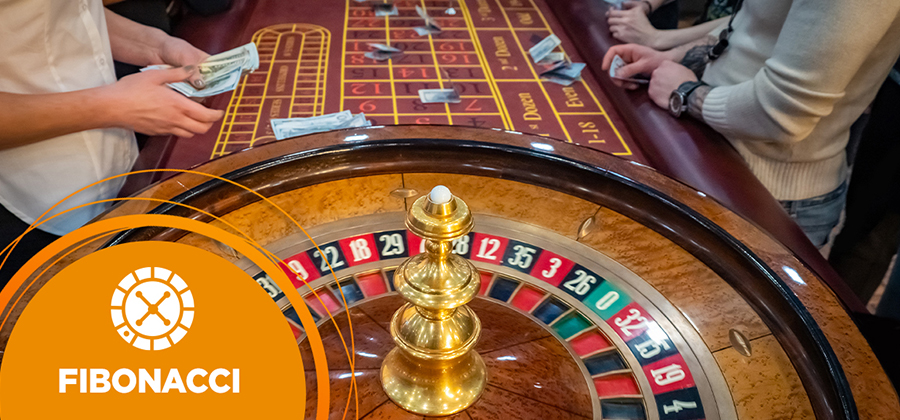The Fibonacci Roulette Strategy is a nuanced betting system that leverages the historical Fibonacci sequence to guide bet sizing in the game of roulette. Rooted in a mathematical sequence that has fascinated scholars and gamblers alike, this strategy offers a distinctive approach to managing bets. It contrasts sharply with more aggressive tactics by focusing on gradual bet increases, aiming to carefully manage the player’s bankroll and mitigate swift losses. Tailored for the strategic player, the Fibonacci roulette system method provides a blueprint for recovery following losses, emphasising patience and discipline. As we explore the intricacies of this method, you’ll discover how to apply this centuries-old sequence to modern gambling, enhancing your roulette experience with a blend of strategy and mathematical elegance.
What is the Fibonacci Roulette Strategy?
The Fibonacci Roulette Strategy utilises the Fibonacci sequence, a mathematical series where each number is the sum of the two preceding ones. This betting system applies the sequence to roulette, guiding players on how to adjust their bet sizes in response to wins and losses. Unlike more aggressive roulette strategies that aim for quick gains, the Fibonacci strategy emphasises long-term stability and gradual recovery of losses. It’s designed for those who prefer a calculated approach to gambling, offering a structured method to manage the inherent unpredictability of roulette. While no strategy guarantees wins, the Fibonacci strategy provides a disciplined framework, potentially enhancing the gambling experience through its systematic application.

How does the Fibonacci sequence apply to roulette?
The Fibonacci sequence finds its application in roulette through a calculated and methodical approach. Starting with the foundational numbers 0 and 1, the sequence unfolds by summing the two preceding numbers to dictate the next bet size after experiencing a loss. This technique advises players to increment their bets in alignment with the sequence after each loss. In contrast, securing a win prompts a strategic retreat, moving back two numbers in the sequence to determine the next bet size. This creates a pattern of progressive betting systems that aims for a gradual recovery of losses, markedly reducing the risk of depleting one’s bankroll rapidly—a common pitfall in more aggressive betting schemes. By adhering to this disciplined strategy, players are equipped to tackle the roulette wheel’s unpredictability, focusing on loss recovery and effective bankroll management.
The sequence starts with 0 and 1, and each subsequent number is the sum of the two preceding ones.
The Fibonacci sequence begins with the numbers 0 and 1, where each following number is derived by adding the two preceding numbers together. This mathematical pattern serves as the foundation for adjusting bets in the strategy.
Players use the sequence to determine bet sizes after losses.
After experiencing a loss, players utilise the sequence to calculate their next bet size, gradually increasing their stakes in alignment with the sequence’s structured advancement. This method focuses on strategic bet management, prioritising loss recovery and the safeguarding of the player’s bankroll.
Steps to Implement the Fibonacci Strategy
To effectively apply the Fibonacci Strategy in roulette, players should begin by placing a bet at the minimum table limit. In the event of a loss, the strategy guides you to advance to the next number in the Fibonacci sequence, methodically increasing the bet size. On the flip side, the Fibonacci betting sequence securing a win prompts a strategic step back two numbers in the sequence to determine the next wager. This move is aimed at recovering previous losses in a measured manner without jeopardising a significant portion of the bankroll at once. Should a win occur right at the sequence’s outset, the strategy calls for a simple reset, starting over with the minimum bet. This structured betting approach emphasises controlled play and long-term bankroll management, making it an ideal strategy for players who prioritise a disciplined approach to gambling.
Begin with a small bet, typically the minimum table bet.
Start your gameplay by placing a small bet. Ideally, the minimum bet is allowed at the table. This conservative approach lays a solid foundation for implementing the Fibonacci Strategy.
After a loss, move to the next number in the sequence for the next bet size.
In the event of a loss, it’s crucial to advance to the next number in the Fibonacci sequence. This progression dictates your next bet size, ensuring a methodical increase in stake in alignment with the strategy.
After a win, move back two numbers in the sequence for the next bet size.
Upon securing a win, the strategy advises a calculated step back by two numbers in the sequence. This move is designed to moderate your bets, focusing on the recovery of previous losses while protecting your winnings.
If you win when betting the first number in the sequence, simply start over.
Achieving a win with the first number in the sequence signals a full circle in the betting strategy, prompting a reset. Begin again with the minimum bet, adhering to a disciplined betting pattern and bankroll management.
Advantages of the Fibonacci Strategy
The Fibonacci Strategy is distinguished by its less aggressive approach to betting, markedly reducing the risk of rapid bankroll depletion—a prevalent issue in many betting systems. Its core principle of recovering losses over several wins rather than seeking immediate recuperation offers a more sustainable method for managing and potentially enhancing one’s bankroll over time. This methodical strategy not only fosters disciplined gambling but also provides a structured betting approach that appeals to players aiming for prudent fund management. By focusing on gradual bet increases and strategic loss recovery, the Fibonacci betting Strategy caters to those who prioritise a cautious yet systematic method in the unpredictable game of roulette.
Less risk of rapid bankroll depletion compared to more aggressive systems.
The Fibonacci Strategy significantly reduces the risk of rapid bankroll depletion, a notable advantage over more aggressive betting systems. It offers a safer betting approach, minimising the potential for quick financial loss.
Designed to recover losses across several wins, not immediately.
Crafted with a focus on long-term stability, the strategy aims to gradually recover losses through a series of wins rather than seeking immediate compensation. This approach encourages a more sustainable and thoughtful gambling experience.
Limitations of the Fibonacci Strategy
While the Fibonacci Strategy offers a disciplined approach to betting, it comes with inherent limitations. One notable challenge is the need for a substantial bankroll to withstand long-losing streaks. This requirement arises from the strategy’s method of incrementally increasing bet sizes following the Fibonacci sequence, which can lead to significant financial risk during extended periods of losses. Furthermore, it’s essential to recognise that this strategy does not alter the inherent house edge in roulette. The casino’s mathematical advantage remains constant, indicating that players cannot depend on the Fibonacci Strategy—or any betting or roulette system itself—to consistently secure profits over time. These limitations highlight the importance of viewing the strategy as a means for bankroll management rather than a guaranteed path to overcoming the game’s odds.
Requires a large bankroll to withstand long-losing streaks.
Employing the Fibonacci Strategy demands a substantial bankroll to navigate through the financial challenges posed by extended losing sequences, emphasising the need for a robust financial cushion.
Does not alter the inherent house edge in roulette.
Importantly, the use of the Fibonacci Strategy does not modify the roulette’s inherent house edge. This limitation highlights the strategy’s function in managing funds rather than offering a surefire way to defeat the game’s built-in advantage.
Fibonacci vs. Martingale Systems
Comparing the standard Fibonacci Strategy used to the Martingale System reveals distinct differences in risk management and overall approach. The Martingale System is characterised by its aggressive tactic of doubling bets after each loss, a strategy that can swiftly deplete a bankroll during a losing streak. Conversely, the Fibonacci Strategy adopts a more conservative method, gradually increasing bets in accordance with the Fibonacci sequence. This approach is designed for steadier play, aiming to mitigate the risk of rapid financial loss by distributing the risk across multiple bets.
While both strategies offer unique advantages, the decision between them hinges on the player’s risk tolerance and bankroll size. The Martingale System might be attractive for those looking for a quick way to recover losses, yet it bears a higher risk of significant financial downturns. In contrast, using Fibonacci’ Strategy provides a safer, more calculated approach, prioritising long-term bankroll preservation and minimising the chances of steep losses.
Martingale doubles bets after a loss, risking rapid bankroll loss.
The Martingale System takes a bold approach by doubling bets after each loss, a tactic that poses a significant risk of rapidly depleting the bankroll during extended losing sequences.
Fibonacci increases bets more gradually, aiming for steadier play.
Conversely, the Fibonacci Strategy adopts a more cautious methodology, incrementally increasing bet sizes according to the Fibonacci sequence. This strategy aims for a more consistent and measured betting pace, prioritising stability over quick recovery.
Practical Tips for Fibonacci Strategy
To leverage the Fibonacci Strategy effectively while navigating its constraints, consider these practical tips. Firstly, setting a clear loss limit is paramount to safeguarding your bankroll against severe losses. Recognising that no betting system, including the Fibonacci, can negate the house edge is vital for maintaining realistic expectations. Engaging in demo mode practice before wagering real money offers a safe space to familiarise yourself with the strategy’s intricacies. Keeping track of your sequence position, whether through a notepad or a mobile app, ensures accuracy in your betting approach. Lastly, being ready to adjust your betting sequence in response to table limits and your bankroll’s health is crucial for the strategy’s sustained applicability. These recommendations highlight the significance of discipline, preparedness, and flexibility when applying the Fibonacci Strategy to your roulette sessions.
Establish a clear loss limit to protect your bankroll.
Implementing a firm loss limit is essential for bankroll protection, preventing the risk of losing more than is financially comfortable.
Accept that no betting strategy can overcome the house edge.
It’s critical to acknowledge that no betting system, the Fibonacci Strategy included, can nullify the casino’s inherent house advantage, setting realistic expectations for gameplay.
Practice the strategy in demo mode before using real money.
Engaging with the strategy in demo mode offers a risk-free opportunity to familiarise yourself with its mechanics, allowing for safe practice before committing real funds.
Keep track of your sequence position with a notepad or mobile app.
Accurately tracking your position in the betting sequence is vital; employing a notepad or mobile app for this purpose can enhance precision and effectiveness.
Be prepared to adjust your betting sequence based on table limits.
Adaptability in modifying your Fibonacci betting system and sequence to align with table limits and your current financial standing is crucial for the strategic application of the Fibonacci method.



 by
by 


